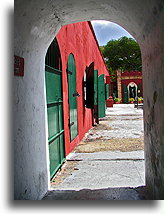

Geographically the Virgin Islands belong to the archipelago of small islands and cays that lie east of Puerto Rico called the Puerto Rican Bank. They include the Puerto Rican islands of Culebra and Vieques, the United States and British Virgin Islands with the exception of St. Croix.
United States Virgin Islands with its luxury resorts, an armada of cruise ships and massive yacht charter industry does not seem to be a place worth to visit. The main island of St Thomas is dense populated and an old town of Charlotte Amalie is nice only on days without cruise ships arrivals. Fortunately what made my visit to this American territory an unforgettable experience is island of St. John with its old plantations' ruins, lush forests and many sandy beaches.

It may surprise most of the first time visitors to the United States Virgin Islands that driving in this American territory is on the left. It is not British influence as many may think. The islands that are today under U. S. flag were Danish dependency not more that 100 year ago. Denmark like all other countries in Europe in 18th century drove on the left. Denmark converted to driving on the right in 1793, but the colony kept the old way of driving. When the United States purchased Danish West Indies at the outbreak of WWI the name was changed to U.S. Virgin Islands, but driving side remained the same, on the left. Today, all vehicles are imported without any upgrades from the mainland U.S. This way all the cars with no exceptions have their steering wheels on the left side. All tollbooths are adjusted to this standard, as is for example the way newspapers a being sold on the street. All this makes left side driving on these islands a little bit different than in other countries with traffic on the left.




